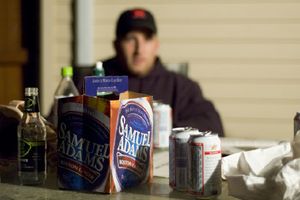Malibu, Mount Gay, or Molson? New SPH study first comprehensive look at youth drinking preferences
Almost 15 years ago, the R. J. Reynolds Tobacco Company ended its Joe Camel advertising campaign after research suggested that the cartoon character was fueling an uptick in youth smoking.

Now, a team of researchers from the BU School of Public Health and the Johns Hopkins Bloomberg School of Public Health will examine the correlation between the drinking habits of young people and marketing campaigns, with a four-year, $2.4 million grant from the National Institute on Alcohol Abuse and Alcoholism.
The study will be the first comprehensive attempt to identify which brands of alcohol young people are consuming and to look at why some brands are more popular than others, says study coinvestigator Michael Siegel, an SPH professor of community health sciences.
“Most of the previous work has looked at things like, are young people drinking beer or wine or liquor—only to that general level,” says Siegel. “So we’ve been really limited in terms of our ability to do a lot of research into youth alcohol preferences and alcohol policy. Being able to drill down to what they’re drinking, and why, will be groundbreaking. It could be a game changer.”
Siegel and David H. Jernigan, an associate professor at the Bloomberg School, will codirect the project, which will involve surveying about 1,000 youths, ages 13 to 20, about the brands they drink, how frequently they drink, and how and where they obtain alcohol. They will be asked about binge drinking, alcohol-related problems such as accidents or fights, and the popularity of novelty items like Jello shots and alcoholic whipped cream.
At the same time, Siegel says, the research team will review brand-specific advertising data from the past several years to explore whether marketing has affected youth drinking patterns.
“The questions we’re going to look at are, what kinds of advertising have these brands done, and is the advertising working?” Siegel says. “We’re expecting to see consumption concentrated among a relatively small number of brands—and if it is, we can look at why young people are choosing those labels. Right now, we don’t know much about what they’re drinking, let alone why.”
“This is a big undertaking,” he says, noting that there are close to 900 different brands of alcohol. “But we’re hoping to inform public policy in a very systematic way.”
Youth drinking remains a significant problem nationally, with the 2010 National Survey on Drug Use and Health finding that 26 percent of youths ages 12 to 20 reported drinking alcohol in the past month and 17 percent reported binge drinking.
In 2009, the national Monitoring the Future survey reported that 37 percent of 8th graders and 72 percent of 12th graders had tried alcohol.
In recent years, a number of medical and advocacy groups have criticized the alcohol industry for ads targeting young people. Among them is the American Academy of Family Physicians, which maintains that alcohol advertisements “overwhelmingly connect consumption of alcohol with attributes particularly important to youth, such as friendship, prestige, sex appeal, and fun.” Several studies have concluded that greater exposure to alcohol advertising contributes to an increase in drinking among underage youth.
While beer companies have dominated spending on major TV networks, studies have shown that distilled liquor marketers have driven a dramatic increase in advertising on cable television in the past decade.
Figuring out the connections between advertising campaigns and youth consumption of specific brands will help groups combating underage drinking to target their efforts, Siegel says.
The new study will expand on the research published in a paper last July in the Archives of Pediatrics and Adolescent Medicine that found links between marketing expenditure and underage drinkers’ brand preferences, as well as higher rates of binge drinking among adolescents who named a favorite brand.
That study, by Dartmouth Medical School and Johns Hopkins Bloomberg researchers, found the most common favorites among the 16-to-20-year-olds surveyed were Smirnoff (for females) and Budweiser (for males). Overall, Smirnoff was the most popular brand for the adolescent drinkers surveyed, but the study did not distinguish between products within the brand, such as Smirnoff Vodka or Smirnoff Ice.
Jernigan, a coauthor of the earlier study, says that a relatively small number of brands are responsible for the bulk of youth exposure to alcohol ads. In 2003, the trade associations representing beer and distilled spirits companies joined the wine industry in committing to placing ads only where the underage audience is 30 percent or less. Some brands have done better than others at avoiding overexposure to youths, Jernigan says.
The American Academy of Pediatrics has advocated for the alcohol industry to restrict advertising in media venues whose audience is more than 10 percent underage.
Siegel has done previous research on advertising targeted to young people. In a study last year, he and other SPH researchers found that Boston’s MBTA was allowing young people to be heavily exposed to alcohol advertising. They found a total of 267 alcohol advertisements on 142 subway cars, an average of about two alcohol ads per car. Based on MBTA ridership statistics, that translates into a total of 1.2 million advertising exposures on a typical weekday, 18,000 of them to youth, the study said.
Submitted by Lisa Chedekel.